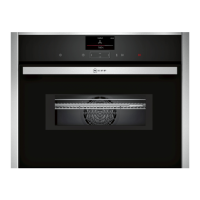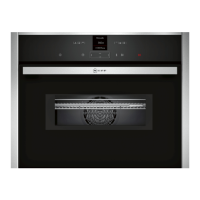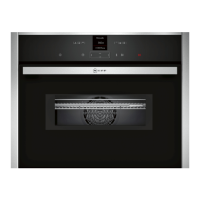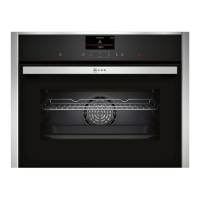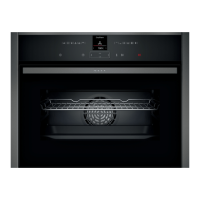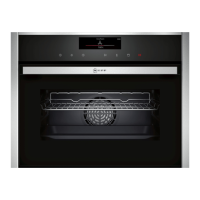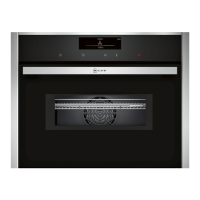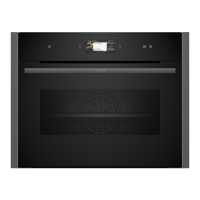Tested for you in our cooking studio en
45
Fish
Your appliance offers you a range of heating types for
preparing fish. You can find the ideal settings for many
dishes in the settings tables.
The whole fish does not have to be turned. Place the
whole fish into the cooking compartment in swimming
position with the dorsal fin facing upwards. Placing half
a potato or a small oven-proof container in the stomach
cavity of the fish will provide stability.
You can tell when the fish is cooked because the dorsal
fin can be removed easily.
Roasting and grilling on the wire rack
Slide the wire rack in at the indicated shelf position with
the imprint "Microwave" facing the appliance door and
the outer rail facing downwards. In addition, slide the
universal pan in at least one shelf position lower, with
the slanted edge facing the appliance door.
Pour up to ^ litres of water into the universal pan,
depending on the size and type of the fish. Any dripping
liquid will be caught. Less smoke is generated and the
cooking compartment stays cleaner.
Keep the appliance door closed when using the grill.
Never grill with the appliance door open.
When grilling, try wherever possible to use pieces of
food which are of a similar thickness and weight. This
will allow them to brown evenly and remain succulent
and juicy. Place the food to be grilled directly onto the
wire rack.
Use tongs to turn the pieces of food you are grilling. If
you pierce the fish with a fork, the juices will run out and
it will become dry.
Notes
■ The grill element switches itself continuously on and
off; this is normal. The set temperature determines
how frequently this occurs.
■ Smoke may be produced when grilling.
Roasting and stewing in cookware
Only use cookware which is suitable for use in an oven.
Check whether the cookware fits in the cooking
compartment.
Glass cookware is most suitable. Place hot glass
cookware onto a dry mat after cooking. If the surface is
damp or cold, the glass may crack.
Shiny roasting dishes made from stainless steel or
aluminium reflect heat like a mirror and are therefore
not particularly suitable. The fish cooks more slowly and
browns less. Use a higher temperature and/or a longer
cooking time.
Observe the manufacturer's instructions for your
roasting cookware.
Uncovered cookware
To cook a whole fish, it is best to use a deep roasting
tin/dish. Place the tin/dish onto the wire rack. If you do
not have any suitable cookware, use the universal pan.
Covered cookware
When cooking with covered cookware, the cooking
compartment remains considerably cleaner. Ensure that
the lid fits well and closes properly. Place the cookware
onto the wire rack.
When stewing, add two to three tablespoons of liquid
and a little lemon juice or vinegar into the cookware.
Very hot steam may escape when opening the lid after
cooking. Lift the lid at the rear, so that the hot steam
can escape away from you.
Fish can also become crispy in a covered roasting dish.
Here, use a roasting dish with a glass lid and set a
higher temperature.
Steaming fish in the microwave
You can also steam fish in the microwave.
To do so, use enclosed cookware that is suitable for
microwave use or use a plate or microwave film to
cover the dish. Observe the notes on cookware suitable
for microwaves. ~ "Microwave" on page 17
This will help retain the flavour and means you can use
salt and seasonings sparingly. If cooking fish whole,
add one to three tablespoons of water or lemon juice.
After cooking, leave the fish to rest for another 2-3
minutes to compensate for the temperature difference.
Take ready-to-eat meals out of the packaging. You can
cook more quickly and evenly using cookware which is
suitable for use in microwaves.
Recommended setting values
You can find the ideal heating type for your fish dishes
in the table. The temperature and cooking time depend
on the amount, composition and temperature of the
food. Settings ranges are indicated for this reason. Try
using lower setting values first. You can use a higher
setting next time if necessary.
The setting values are based on the assumption that
chilled fish is placed into a cold cooking compartment.
By doing so, you can make energy savings of up to 20
per cent. If you preheat the oven, you can reduce the
indicated cooking times by several minutes.
In the table, you can find information for fish with default
values for the weight. If you want to cook a heavier fish,
you should definitely use the lower temperature. If
cooking several fish, you should use the weight of the
heaviest fish as a reference for determining the cooking
time. The individual fish should be approximately the
same size.
As a general rule: the larger a fish, the lower the
cooking temperature and the longer the cooking time.
Turn any fish which is not in swimming position after
approx. ^ to Z of the indicated time.
The meat gets burned during brais-
ing.
The roasting dish and lid must fit together well and close properly.
Reduce the temperature and add more liquid when braising if necessary.
The roast is not well-done enough. Carve the roast. Prepare the sauce in the roasting dish and add the sliced roast meat to the sauce. Finish
cooking the meat using the microwave only.
